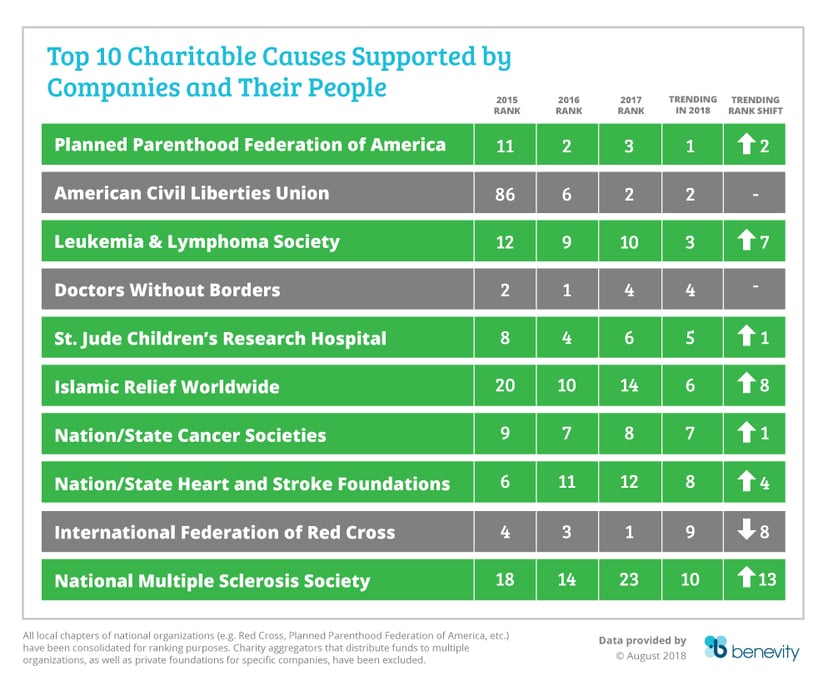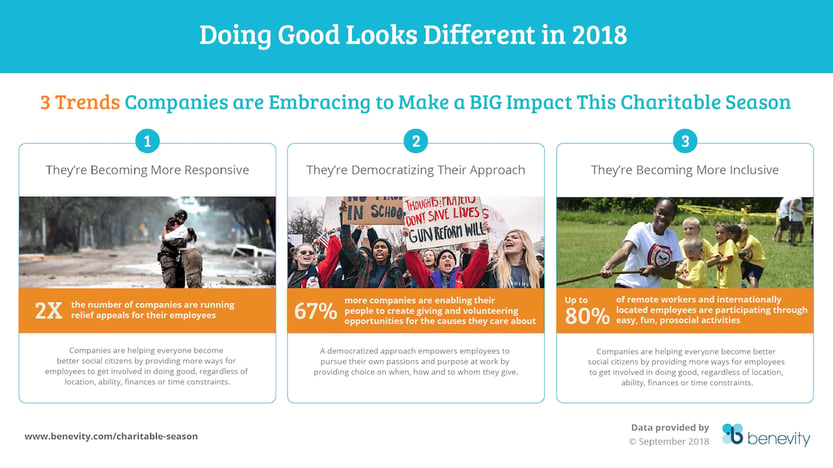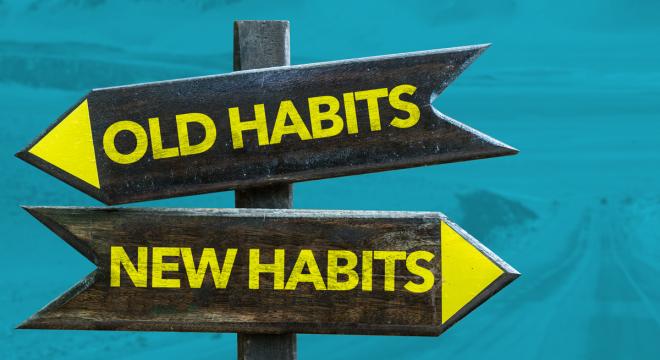And this could be just the beginning of a positive trend. Despite these seemingly huge numbers, most Americans are only half as charitable as they intend. A recent study by Ideas42 (which is nicely summarized in an article by Fast Company) highlighted the fact that we are donating 3% of our annual income to charity versus the 6% we feel like we should be giving. They talk about the “gap between ambition and action” costing charities about $291 billion in potential donation dollars.
To help bridge that gap, progressive and purpose-driven brands are adopting new strategies to engage their people in more social impact. As companies gear up for the biggest giving season of the year — September through December, make-or-break months that bring in around 50% of annual income for nonprofits and charities — here are a few trends we’re seeing that can really move the needle.
Which causes are we supporting this year?
Every year, Benevity releases data around the top causes companies and their people are supporting through our platform. Here’s this year’s data.

You’ll notice that now more than in the last decade, we are seeing more causes related to human rights and crisis relief holding the top 10 spots — this year it was half. We saw this shift take root back in 2016 and we are seeing it continue into 2018. While we may have believed this was a blip because of the election cycle, it now seems to be the "new normal.” To us, this chart is less about the specific charities and more about the fact that people want to give to the causes that are most relevant to them, most timely to support and ones that are pertinent to society. It’s less about companies backing a specific cause, and more about companies backing their people and their passions.
Data shows that doing good looks different in 2018
Among the hundreds of enterprise companies that are partnered with Benevity, we’ve seen countless examples of innovative, people-driven campaigns that really move the mark and set new standards when it comes to making a positive social and environmental impact. But what’s more interesting is that they all fit into three key trends that are shaping how companies engage more people, maximize their impact and foster compelling, purpose-driven workplace cultures. They all have one thing in common — they are harnessing the power of their people!

After assessing our data from the last year, we’ve seen corporate “Goodness” programs — which include workplace giving, matching, volunteering, grantmaking and other prosocial actions — become more:
Responsive
$327 million in donations were made to 22,000 relief, human services, advocacy and related organizations through Benevity’s platform. This is an incredible amount of support and it’s increasing because more than two times the number of companies are publishing relief appeals to help their people give in times of crisis, whether it’s natural disasters or “man-made” events. And, many of them run special matching (2-to-1 or even 3-to-1) to multiply the impact of their people's donations. Companies are getting increasingly pro-active in their planning for these types of events which is helping them mobilize faster when help is needed. In fact, we saw 97% of total donations to Hurricane Harvey made within 20 days of the disaster. It’s incredibly powerful when employees can leverage a company matching program when they feel the urge to give.
Disasters aren’t the only occasion where we’re seeing responsive programs drive success. In response to what they believe is a national crisis involving gun violence in the U.S. and to stand up for what they believe is right, Levi Strauss & Co. stepped up its support for gun violence prevention. They established a new grantmaking fund that will direct $1 million to relevant nonprofits, lent their CEO’s voice to the issue and incentivized participation from employees who share the concern with a 2-to-1 match for donations to organizations preventing gun violence and offering volunteer rewards for advocacy efforts.
Some companies went even further this past year and involved their customers and communities in these appeals, in addition to their employees, through branded giving portals that allowed the public to give online with a real-time match provided by the company. QVC raised $500,000 for hurricane relief doing it this way and using their TV slot to promote their matching campaign. This was a great example of a company using its unique resources to rally broad support.
Democratized
More and more companies are opening up their workplace giving programs to allow their people to donate to and volunteer with the organizations of their choice (versus the ones that the company sponsors or supports). But this year, we saw something really awesome!
A whopping 67% more companies are empowering their people to create and publish giving and volunteering opportunities for the causes they care about. This is the biggest shift we’ve seen this year — one that we believe will bring the most transformation to our space and get more new donors and volunteers engaged in social good. Why? Because 45% of first-time donors get involved through a specific giving opportunity or campaign, helping them make the leap from ambition to action.
On the flip side, we also know that the number one reason people don’t give is because they weren’t asked. This trend shows the power of letting employees do the asking. I know I’m more likely to give when an individual colleague reaches out for support for a cause they care about, admittedly even more than when the company does!
Inclusive
Diversity and inclusion are top of mind this year. And we are seeing more and more companies authentically embrace this critical issue by removing the barriers to their employee programs that may have once limited people's ability to get involved. In fact, we are seeing what I’d call “Acts of Radical Inclusion” where companies are making this a core tenet within their culture and seeing record participation as a result.
From an employee perspective, they are looking for meaning and purpose through their workplace that goes beyond their day-to-day job. They want to feel like they belong. Being able to participate in employee programs in ways that are personal is a powerful way to build a culture of belonging.
Companies are tackling inclusion and belonging (and generating greater social impact) by introducing new ways for people to do good. In addition to donation, matching and volunteer programs, companies like PayPal are engaging up to 80% of their remote workers and internationally located employees by offering them easy, fun, prosocial activities to engage in (what we call “Missions”) — like riding their bike to work, eating meatless meals for a week, or powering off their electronics at the end of the work day. With a platform that allows them to track, and even gamify, these behavioral changes, companies are seeing unprecedented employee participation in social good programs. They're building purpose-driven cultures in a grassroots way and reaping all of the benefits of a more engaged and impassioned workforce.
Business can help close the gap this “Giving Season”
We’re fast approaching the time of year where we all are a little more intentional about supporting the causes we care about. Companies who are adopting these three trends as part of a more strategic approach to their workplace culture and social impact programs have the power to bridge the gap between our ambition and our action, and help us be better versions of ourselves at work and in the world.









